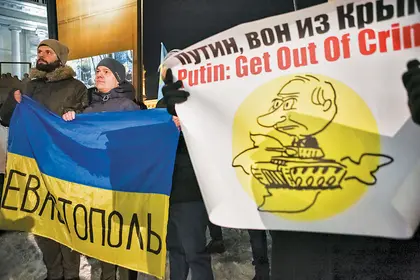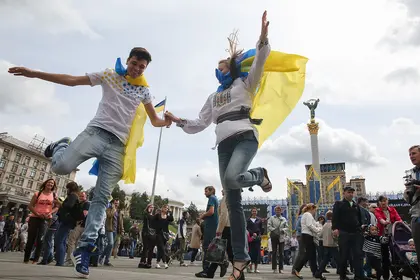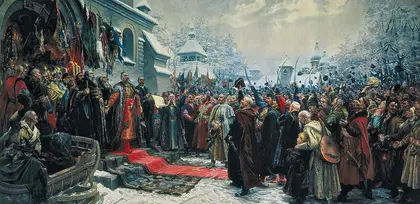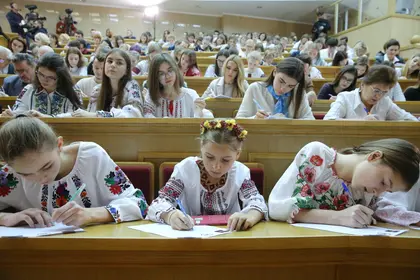Editor’s Note: This is the 12th story in the Kyiv Post’s Honest History series, which aims to debunk myths about Ukrainian history. The series is supported by the Black Sea Trust, a project of the German Marshall Fund of the United States. Opinions expressed do not necessarily represent those of the Black Sea Trust, the German Marshall Fund or its partners.
Two days after the Kremlin held a sham referendum at gunpoint in Crimea on March 16, 2014, in an attempt to justify the illegal annexation of the Ukrainian peninsula, Russian President Vladimir Putin addressed his nation.
JOIN US ON TELEGRAM
Follow our coverage of the war on the @Kyivpost_official.
“In hearts and in minds of the people, Crimea has always been and remains an integral part of Russia,” he said, falsely claiming that Crimeans had unanimously made a free choice to leave Ukraine and join Russia.
Ukraine and its Western allies called the Crimean referendum illegitimate because it came only weeks after Russian troops invaded and occupied the peninsula, installing pro-Kremlin authorities at the point of a gun. The ballot offered two choices for Crimea — to join Russia or to remain a part of Ukraine but under the Crimean Constitution of 1992, which meant more autonomy and Russian as the official language.
In the meantime, Russia glorified the occupation as the reclaiming of Russian land. The “reunification” campaign ran under the slogan “Krym nash” or “Crimea is ours.”
But who does Crimea really belong to — Russia or Ukraine?
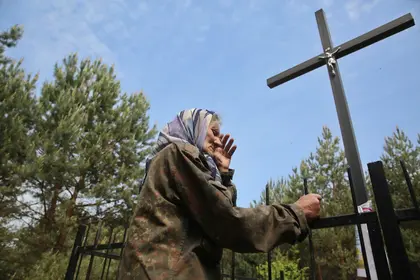
Honest History 8: Volyn Tragedy — Polish, Ukrainian ethnic cleansing still used as political tool
Crimea had indeed formerly been part of Imperial Russia and then Soviet Russia. However, by order of Soviet leader Nikita Khrushchev, in 1954 Crimea was turned over to Ukraine, and it remained part of Ukrainian territory after the disintegration of the Soviet Union — until Putin said he would “restore historic justice” in 2014.
In the civilized world, Russia’s brazen invasion and occupation of Crimea is seen as the first attempt to redraw borders by force since World War II.
In addition, Russia violated a number of international laws and agreements, such as the 1994 Budapest Memorandum, the 1997 Treaty of Friendship between Russia and Ukraine, the 2003 Agreement on State Borders, and the Helsinki Accords.
Dreams of antiquity
Putin’s obsession with Crimea has roots in Russian czar Catherine the Great’s obsession with ancient Greece.
In the 18th century, Catherine II nurtured the idea of a new Orthodox Christian state with its capital in Constantinople, which would be ruled by her grandson Constantine. The Russian throne was intended for another grandson of hers, Alexander. The boys were given Greek names on purpose.
“Russia got its religion from the Greeks. Orthodox Christianity came from Byzantium,” wrote Russian historian Andrey Zorin in his series of lectures “The Origins of the Crimean Myth.”
But the Byzantine capital Constantinople had been conquered by the Muslim Ottomans in 1453 and renamed Istanbul. In Catherine’s mind, she had to win back Greece from the Turks, thereby liberating the cradle of Orthodox Christianity and of European civilization — which was believed to have been born in ancient Greece.
The empress first set her sights on the Crimean Khanate, a vassal state of the Ottoman Empire stretching across the Crimean peninsula and the Black Sea coast. There, where the modern-day city of Sevastopol now stands, there had been the Greek colony of Chersonesus, where Prince Volodymyr the Great, a Kyivan Rus ruler, had been baptized in 988, heralding the Christianization of the formerly pagan Kyivan Rus.
After eight years of war, Russia and Ottoman Turkey in 1774 finally signed a peace treaty that formally declared Crimea an independent state, after three centuries under the Ottomans.
Moreover, Russia got control over two key seaports in the Black Sea, Azov and Kerch, and became the declared protector of all Orthodox Christians who lived in the Ottoman Empire.
“Initially, Catherine didn’t plan to annex the conquered territories to Russia. She wanted to expand the empire’s influence, not its borders,” wrote Zorin.
Instead, it was Russia’s military commander and Catherine’s favorite, Grigory Potemkin, who decided the fate of Crimea.
In the late autumn of 1782, he sent a handwritten note to the empress in which he persuaded her to annex the peninsula. In his words, Crimea’s geographical location gave Russia unimpeded access to the Black Sea and security on its borders with Turkey.
“If you don’t conquer it now, there will be a time when everything we get for no cost now will be achieved at a high price,” he wrote. “You are obliged to aggrandize the glory of Russia.”
So in 1783, Crimea was annexed by Russia without a single shot fired.
To fully establish the myth of Russia’s being an offshoot of Hellenic culture, Turkish and Tatar geographical names of cities on the peninsula were changed to Greek-sounding ones.
Qırım became Taurida, Aqmescit became Simferopol, Kaffa — Feodosia, and Kezlev — Eupatoria. And on the ruins of the ancient Chersonesus, the Russians built Sevastopol.
Except for two cases, the new Greek names were invented, Zorin wrote.
Kelly O’Neill, a professor of history at the Harvard University, hears echoes of the first Russian annexation in the Kremlin’s modern-day rhetoric, as Putin aims to make Russia a great geopolitical power again. According to her, while the strategic value of Crimea is obvious in military terms, the peninsula also has an equally important symbolic significance to the Kremlin.
“It is as much about Crimea itself as it is about the projection of Russian power well beyond the peninsula,” O’Neill wrote in her 2014 essay “From A Historical Perspective, This Is Why Crimea Matters.”
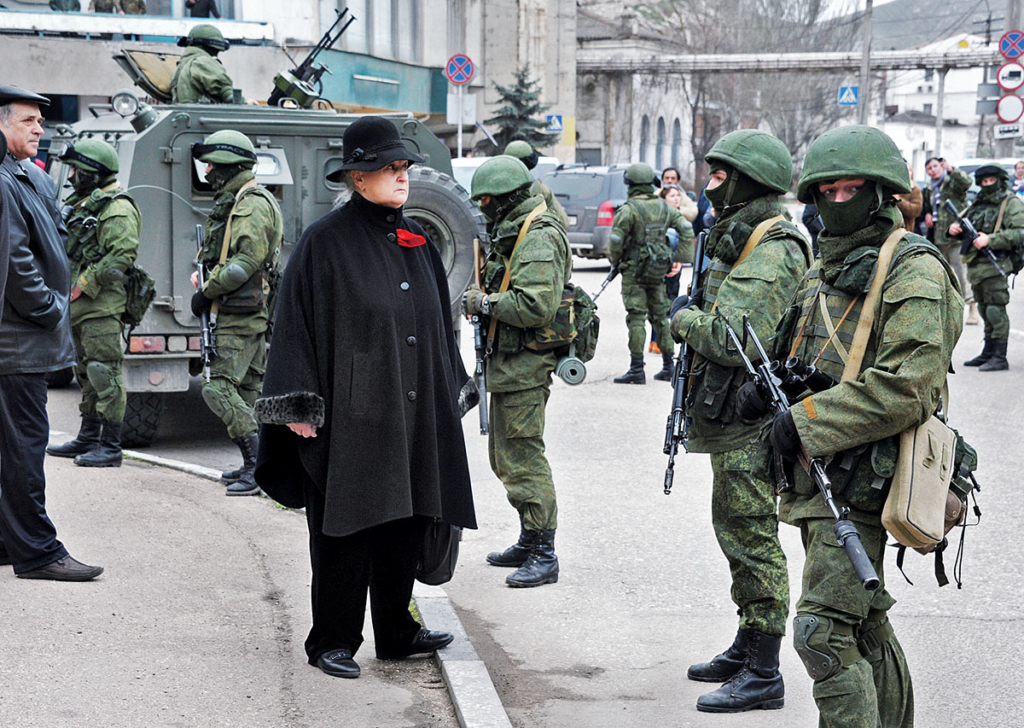
Russian world
At the meeting with G7 leaders in June, U. S. President Donald Trump reportedly said that Crimea is Russian because everyone who lives there speaks Russian.
While that is false, ethnic Russians did comprise over a half of Crimea’s population in 2014 when Russia invaded the territory. Ukrainians, many of whom also spoke Russian, were the second largest ethnic group at around 20 percent of the population. The indigenous people of Crimea — the Crimean Tatars, who practice Islam and whose native language has Turkic roots — made up only 11 percent of the total population. Many of them speak Russian too.
The extensive Russification of Crimea started after World War II, and would not have been possible had the peninsula not been ethnically cleansed in 1944 on the orders of Soviet leader Joseph Stalin. The Crimean Tatars and other ethnic minorities were rounded up and deported to Central Asia, having been falsely accused of collaborating en masse with the Nazis.
In fact, Stalin’s repressions paved the way for Russia’s 2014 invasion of Crimea.
To justify the invasion, Putin announced that its transfer to Ukraine in 1954 was a violation of Soviet laws. He based his territorial claims on the preposterous allegation that there was a threat to the ethnic Russians living in Crimea, who made up the majority of the peninsula’s population. He said they faced forced assimilation and were being deprived of their native language by Ukrainian nationalists, whom Kremlin propaganda portrayed as “anti-Semite, Russophobe, neo-Nazi” thugs who had taken control of the country after President Viktor Yanukovych was toppled in the EuroMaidan Revolution in 2014.
All these lies were used by Putin as a cover for the well-planned Russian operation to invade and occupy Crimea, which had obviously been prepared well ahead of the EuroMaidan Revolution, and which is part of Putin’s overarching goal of extending Russian control and influence in the “near abroad,” as the Kremlin calls the countries apart from Russia that were once part of the Soviet Union.
For Putin, the collapse of the Soviet Union was a huge geopolitical tragedy, and his imperial ambitions are conceptualized by “Russkiy Mir” or “the Russian World” — the idea of the unity of Russian-speaking people in Eastern Europe, the Caucasus, Central Asia, and the Baltics.
In her 2016 book “Beyond Crimea: The New Russian Empire,” Lithuanian-American scholar Agnia Grigas described how Putin has used the so-called “compatriot protection” to justify his territorial encroachment in Moldova, Georgia, and Ukraine.
Just as Catherine the Great saw it as her mission to protect Orthodox Christians living in the Ottoman Empire, Putin sees it is his responsibility to protect “compatriots” — a broad term that includes not only ethnic Russian minorities in former Soviet countries but also Russian language speakers and “those who feel inseparably connected to the Russian world.”
Grigas wrote that for this, the Kremlin uses a variety of tools — from soft power and covert influence, to propaganda and issuing Russian passports. Another common manipulation tool is to falsely claim there have been violations of the human rights of an ethnic Russian minority abroad, or discrimination against Russian speakers.
But as demonstrated by the subsequent Kremlin military intervention in Ukraine’s eastern Donbas region, in which over 10,300 Ukrainians have died, the biggest danger to Russian speakers living outside Mother Russia is in fact the Kremlin and its armies.
You can also highlight the text and press Ctrl + Enter


